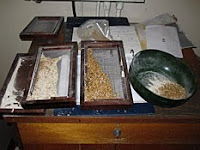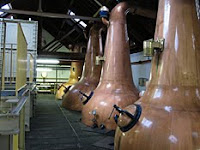
Macallan is one of the most famous distilleries and whisky brands in the world. It is located close to the village of Craigellachie in the heart of the Speyside region of Scotland, overlooking the River Spey. Macallan was founded in 1824 by Alexander Reid and was originally called Elchies distillery, after an area of land nearby. The name was changed to Macallan in 1892 following a change of ownership.
Macallan is currently owned by the Edrington Group and most whisky is released as single malt, although some does go into Edrington's popular Famous Grouse blend. The distillery sits within a huge 93 acre estate that includes the famous Elchies House, which appears on all Macallan packaging and labels. The range of whiskies is extensive and are some of the best selling around the globe. Macallan is consistently in third place for sales of single malt, behind only Glenfiddich and Glenlivet, with particular strong performances in the American, UK and travel retail markets.

Our tour begins in the modern visitor centre that was opened in 2001. The visitor centre is whitewashed with wooden finishes and is stocked with the Macallan range of whiskies and various other whisky related items (and some not so whisky related souvenirs!). Our guide explains a little about the Edrington Group, the Famous Grouse blend and then Macallan before leading the group off down an attractive path to the next part of the tour (
pictured left). We were told that no photographs were allowed inside any buildings "for safety reasons", although photos outside were OK - this is strange, as other distilleries actively encourage you to take photographs in all areas and it makes you think that Macallan have actively chosen this approach and obviously don't want you to take any photos for some reason.
The first stop is the up some steps to a small presentation area that is set up next to a mash tun. Here there are some back lit photos showing microscope images of the three ingredients used in whisky making - water, yeast and barley. There are also exhibits showing some old scientific equipment and our guide explains the basics about each of the ingredients. We then move on to the large steel mash tun and a brief description of the mashing process, although there was nothing in the mash tun for our visit. This did allow us to see the the full size of the interior of the mash tun and also the mixing blades that keep everything moving. We then move on to a room containing six wooden washbacks. The fermentation process was briefly explained but again, there was nothing in any of the tanks to observe.
It is at this point that our guide explained that we were standing in the recently renovated old section of the distillery that was completely rebuilt and started production in September 2008. This raised Macallan's annual production capacity from six million to eight million litres. The main part of the distillery houses a further mash tun and 16 washbacks and it was explained that this is where the majority of production still takes place, which was why nothing was going on in the renovated section on the day of our visit. It is certainly impressive but clinical and it makes the decision to not allow any photographs even stranger as nothing was happening!
We then move through to the stillroom that has also been recently renovated. There are six stills inside - four wash stills and two spirit stills - and this is in addition to the 15 stills that are housed in the main part of the distillery (10 wash stills and five spirit stills). Again, none are in operation but it does give us the chance to look inside a still, which we have never seen before. The stills at Macallan are small and onion shaped with the lyne arms forming an arcade that you can walk under, reach up and touch. The distillation process is explained and we are led to the spirit safe and shown a display with clear liquid running through. This was odd as none of the equipment was working and when someone asked how this was happening, our guide explained that it was in fact water being pumped through in order to show what the spirit would look like.

Next, we were whisked passed the adjacent main part of the distillery, which was operating, (
pictured left) and told not to stop as the tour had to continue! Our guide took us to a warehouse where the maturation process and conditions were explained, along with the different sizes of casks used. We were in a caged area in one corner of the warehouse, that is one of 16 dunnage stone warehouses at Macallan. They also have 21 huge racked warehouses, including one that was the largest bonded warehouse in Europe at the time of its construction with a capacity of 80,000 casks.
The tour then moved upstairs to an exhibition about the types of wood used in cask construction, the differences between them, how they make casks and the different types of casks. There were more backlit microscope images of wood grain structure and an nice photographic display of the time line of Macallan's bourbon casks and sherry butts that start as separate stories, before joining up with images of Macallan at the end. There is also the 'aroma tunnel', which is a series of glass tear-shaped vessels hanging from the ceiling that you walk through. Each vessel contains a flavour or aroma characteristic that is associated with Macallan whisky, such as dried fruit, nutmeg, citrus etc, and you are invited to smell these. A lot of thought and money had obviously gone in to this exhibition and it was certainly interesting and refreshingly interactive.

Finally, it was back to the visitor centre for a sample of the
Macallan 10 years old. It has to be commented that this was a particularly small sample compared to every other distillery that we visited (it barely covered the bottom of the glass!). As a result, Macallan has sadly won our 'Meanest Dram of the Tour' award. We only received one dram as well and this was of their standard whisky, which is unimaginative and again disappointing compared to every other distillery visit. The Macallan 10 years old is an excellent whisky but is ultimately the cornerstone of Macallan's range and the most readily available of all their whiskies. We would guess that every person on that tour had tasted it before, judging by their negative reactions.
We have to admit to being slightly disappointed by our visit to Macallan, especially as we both love Macallan whiskies. The setting is gorgeous but the place feels too corporate, clinical and lacking in passion. We are sure that this is not the case but that is just how it felt during our visit and this was backed up by comments from others on our tour. Our guide seemed to be disinterested and going through the motions throughout and answered questions curtly, the result of which was that people stopped asking questions towards the end. Despite this, there were many excellent innovative points of interest that were unique to this tour - the newly renovated mash/washback/still room, the wood and cask exhibition, the photographic displays and the 'aroma tunnel'. However, the feeling is that this is more of a whisky experience than a distillery tour. Maybe we were just unlucky that there was no production on the day of our visit but we left feeling a bit short changed.
Tour detailsEntry - £5 per person (booking essential)/ Tour duration - 1 hour/ No. of drams - 1/ No. of people on tour - 15 / Further details -
www.themacallan.com
 Spice Tree is a new release from Compass Box, a independent bottling company with a difference. A version of Spice Tree was originally released in 2005 but was discontinued shortly afterwards due a legal wrangle with the Scotch Whisky Association (SWA). This first Spice Tree gained good reviews from the trade and consumers but the problem lay in the maturation method. In Scotland, casks must have been previously used and nothing must be added to alter the flavour. Compass Box introduced new oak staves that they placed in to the casks and these created a greater surface area between the wood and the whisky, therefore increasing the flavours artificially. This method is similar to the one commonly used in the wine industry.
Spice Tree is a new release from Compass Box, a independent bottling company with a difference. A version of Spice Tree was originally released in 2005 but was discontinued shortly afterwards due a legal wrangle with the Scotch Whisky Association (SWA). This first Spice Tree gained good reviews from the trade and consumers but the problem lay in the maturation method. In Scotland, casks must have been previously used and nothing must be added to alter the flavour. Compass Box introduced new oak staves that they placed in to the casks and these created a greater surface area between the wood and the whisky, therefore increasing the flavours artificially. This method is similar to the one commonly used in the wine industry.



































